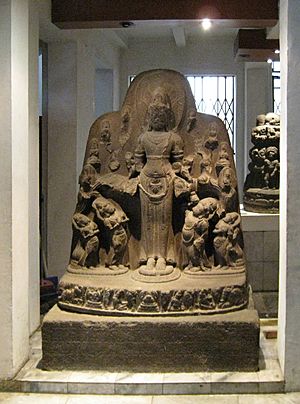Kertanegara of Singhasari facts for kids
Quick facts for kids Sri Maharajadiraja Sri Kertanegara Wikrama Dharmatunggadewa |
|||||
|---|---|---|---|---|---|

The Singhasari temple of Kertanegara
|
|||||
| King of Singhasari | |||||
| Reign | 1268 – 1292 | ||||
| Predecessor | Visnuvardhana | ||||
| Died | 1292 | ||||
| Spouse | Sri Bajradewi | ||||
| Issue | Gayatri Rajapatni | ||||
|
|||||
| Dynasty | Rajasa dynasty | ||||
| Father | Visnuvardhana | ||||
| Mother | Jayawardhani | ||||
Kertanegara (also known as Kritanagara or Sivabuddha) was a very important king of the Singhasari kingdom in Java. He ruled from 1268 to 1292 and was the last king of Singhasari. During his time, Java became much stronger in trade and power. Its influence reached many parts of the Indonesian islands.
Contents
Early Life and Beliefs
Kertanegara was the fifth ruler of Singhasari. His father was King Wisnuwardhana, who ruled before him. Kertanegara started to have power in 1254 and officially became king in 1268 after his father passed away. The Singhasari kingdom began when Ken Arok took over the Kediri Kingdom in 1222.
Kertanegara followed a special mix of Hinduism and Buddhism. This was a mystical (spiritual) belief system called Tantric syncretism. He saw himself as a "god-king" who was both Shiva (a Hindu god) and Buddha. Kertanegara held many religious events and ordered the creation of sculptures and metal art during his rule.
Expanding the Kingdom
Singhasari was at its strongest under Kertanegara. He greatly expanded Java's power into Sumatra, the Malay Peninsula, and Bali. He also increased Java's involvement in the profitable spice trade with the Maluku Islands. Kertanegara also stopped rebellions in Java, like those by Cayaraja in 1270 and Mahisha Rangkah in 1280.
Kertanegara was the first Javanese ruler who wanted to expand his kingdom beyond Java. In 1284, he made nearby Bali a part of his kingdom. Kertanagara also made an alliance with Champa, another powerful state in Southeast Asia.
Later in his rule, an important journey called the Pamalayu expedition helped him gain control of the Melayu Kingdom in eastern Sumatra. He might have also gained control over the Sunda Kingdom and power over the Strait of Malacca. Other areas like Madura Island and Borneo also accepted Kertanegara's rule.
Facing the Mongols
After conquering China, the Mongol Yuan dynasty wanted to expand its power into Southeast Asia. In 1289, Kublai Khan, a grandson of Genghis Khan, sent his messengers to Java. They asked Kertanegara to pay tribute (a payment showing respect to a stronger ruler). Kertanegara was very offended by this request. He arrested the messengers, marked their faces, cut their ears, and sent them back to China.
Kertanegara knew the Mongols would send an army to punish him. So, he tried to make his kingdom stronger. Around 1290, he sent the Pamalayu expedition to Sumatra. His goal was to conquer Jambi in the south. Jambi was one of the first places in Indonesia where Islam was present, and it already had good relations with Yuan China.
Kublai Khan ordered a large naval (sea) army to be sent to punish Kertanegara in 1292.
The Rebellion of Jayakatwang
While the Mongol fleet was on its way, a big change happened in Java. Jayakatwang, a prince from Kediri and a powerful leader under Singhasari, rebelled against Kertanegara. Most of Java's army was away on campaigns. This left Singhasari's defenses weak. Jayakatwang used this chance to attack Kertanegara. He first launched a fake attack in northern East Java. This drew the remaining Singhasari troops away from the capital city. With the capital, Kutaraja, unprotected, Jayakatwang attacked the city from the mountains in the south.
Kertanegara and many of his officials were killed in his palace in Singhasari in May or June 1292. Jayakatwang then declared himself the new ruler of Java and king of the restored Kediri Kingdom.
One of Kertanegara's few surviving relatives was his son-in-law, Raden Wijaya. He escaped to Madura Island, where he was protected by its leader, Arya Viraraja. Wijaya then settled in the area near the Brantas delta. There, he built a settlement that would later become the powerful Majapahit empire.
Kertanegara's Lasting Impact
Raden Wijaya used the approaching Mongol troops to help him overthrow Jayakatwang. Wijaya then turned against his Mongol allies, who were tired after the war. He drove them out of Java and established Majapahit. This empire became one of the greatest to rise in the area of modern Indonesia.
Kertanegara did not have any sons. However, through his daughter Gayatri Rajapatni, who married Raden Wijaya, Kertanegara became an ancestor of the Rajasa dynasty. This was the ruling family of Majapahit. His daughter Gayatri and his granddaughter Tribhuwana Wijayatunggadewi would both become queens of Majapahit. His great-grandson Hayam Wuruk became the greatest king of Majapahit. Under his rule, Majapahit became one of the biggest empires in Nusantara (the Indonesian archipelago).
Kertanagara was later honored as Mahaksobya Dyani Buddha by his descendants in the Wurare Inscription.
See also
In Spanish: Kertanegara de Singhasari para niños


